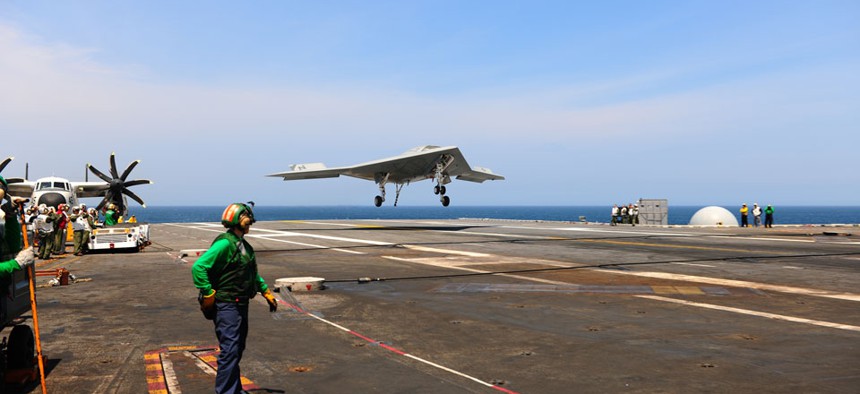Unmanned Aircraft Aborted Its Third Carrier Landing Attempt Following Computer Failure

The X-47B lands aboard the USS George H.W. Bush aircraft carrier off the coast of Virginia. U.S. Navy
The Navy’s X-47B was the first drone to make an arrested landing aboard an aircraft carrier.
As every good seaman knows, a salty dog is an experienced sailor savvy enough to do the right thing when confronted with a problem. That’s exactly what the Navy’s X-47B unmanned aircraft -- with the call sign “Salty Dog” -- did when an onboard computer failed as the drone attempted its third arrested landing on the USS George H.W. Bush aircraft carrier off the coast of Virginia yesterday.
The X-47B already had completed two landings, including the historic first carrier landing of an unmanned aircraft on a flight from Naval Air Station Patuxent River.
The second landing followed less than an hour later after a launch from one of the carrier’s catapults. After a second catapult launch, the drone zoomed around for yet another landing. That’s when one of three redundant onboard computers failed, four miles from the carrier deck, as the aircraft approached for its third landing.
In a briefing for reporters Thursday, Rear Adm. Mat Winter, program executive officer for Unmanned Aviation and Strike Weapons, said the aircraft’s computers constantly poll each other’s health. When two computers detected the failure of the third, the aircraft executed an “autonomous wave off” -- it pulled up and awaited instructions from an onboard, human mission control operator.
Due to safety considerations, flight testers decided to forego the third carrier landing and directed the X-47B to land at NASA’s flight facility at Wallops Island, which was closer to the carrier than the Navy’s Patuxent River facility. Winter said the failure of the computer wasn’t a big deal in a test program. “As in every test, we have some anomalous behavior,” he said.
Carl Johnson, vice president and program manager for unmanned combat air systems at Northrop Grumman, which developed and manufactured two X-47B aircraft under a contract with an estimated value of more than $800 million, said fixing the failed computer may require an exercise familiar to anyone with a PC -- reboot it.
On the two completed landings, the X-47B came within inches of the planned landing spots on the deck, Johnson said, which he described as a “phenomenal performance.”
Capt. Jaime Engdahl, program manager for the X-47B, said the aircraft can land with such accuracy because it uses a more precise version of Global Positioning System technology installed onboard the ship and the aircraft that determines the location of both the ship and the aircraft in real time.
Winter said this information is transmitted over the government-owned Tactical Targeting Network Technology waveform, which can transmit data at a maximum rate of 10 megabytes per second with a range of 300 nautical miles.
The Navy plans to conduct additional test landings on the same aircraft carrier July 15 and later this year will test air-to-air refueling tests with a Learjet equipped with the same systems as the X-47B. The X-47B program is funded through the end of this year, after which the Navy will retire the two demonstrators and offer them to museums, Winter said.
Winter said lessons learned from the X-47B program will help the Navy develop future generations of carrier-based unmanned aircraft.






